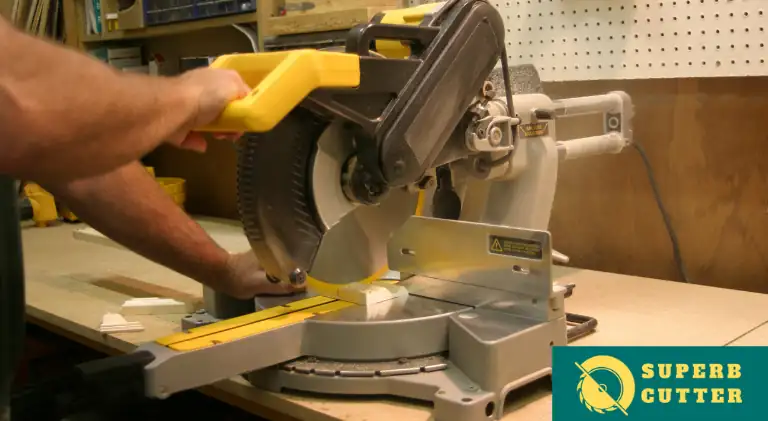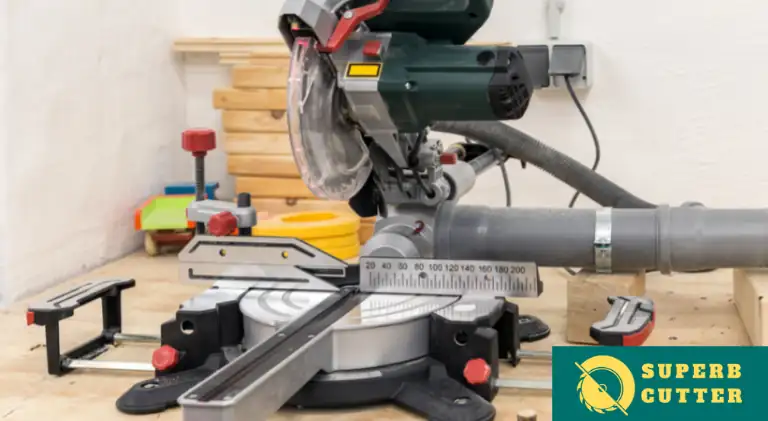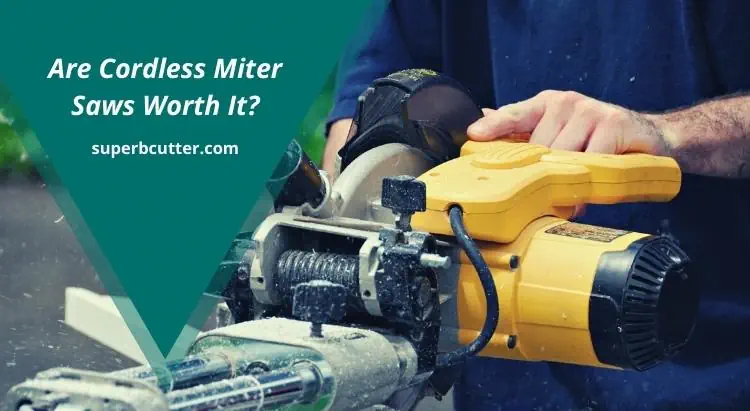Miter Saw vs Radial Arm Saw – (Read This First)
Looking for a thorough comparison of a miter saw vs radial arm saw?
I know it can be hard to know which saw is best for your needs. But you don’t have to worry at all because you have already come to the right place. This article will help you understand the difference between a radial arm saw and a miter saw so that you can choose which one is best for you.
Both of these tools are used in carpentry work. Both of them make similar types of cuts, but the process is a little different. The difference between these two types of saw is their shape and size.
Let us discuss more Miter Saw vs Radial Arm Saw; how they work and where they are used and their advantages and disadvantages.

Miter Saw vs Radial Arm Saw: How they Work?
A radial arm saw is a power tool that has a long arm with a circular blade attached to the end of it. This blade protrudes out from the side of the machine. You can move this arm up down, left, and right using a control mechanism attached to the front of the saw.
Also, the arm can be extended or retracted so that you can cut long or short pieces of wood depending on your needs. A miter saw also uses a circular blade but its layout is different than radial arm saws.
It resembles an electronic carpenter’s square with a handle. A miter saw also has a control mechanism used for adjusting the blade’s position. It can be adjusted vertically too so that thick pieces of wood are cut easily.
Miter Saw vs Radial Arm Saw: Positioning of Blade
The main difference between these two types of saws is their positioning of the blade in relation to the base.
In a radial arm saw, the blade is positioned over the workpiece horizontally while in a miter saw the blade is positioned vertically. The positioning of the blades is one of the main things that make these saws different from each other.
Due to this change in the position of the blade, their operating mechanism also differs slightly. A radial arm saw needs to be pulled in the horizontal direction in order to make a cut while a miter saw requires pushing it in a vertical direction.
Miter Saw vs Radial Arm Saw: Where can they be used?
Radial arm saws are bigger and bulkier than miter saws and cannot be moved easily to different job sites. It is usually fixed to the ground or under a workbench so that it does not get in your way when you are doing work.
But because of its size, radial arm saws cut big pieces of wood very efficiently. Miter saws on the other hand are smaller and lighter than radial arm saws and can be carried easily to different work sites.
Due to their small size (compared to the Radial arm saws), they are mostly used in different workshops and woodworking professionals love them. it is because they are easy to move around and carry whenever needed.
Miter Saw vs Radial Arm Saw: Advantages of Each
Radial arm saws are very powerful and can cut large pieces of wood easily, but they are bulky. These types of power saws can easily cut logs and lumber pieces of almost any size without having any issue at all. Whether you are working on a 2×4 piece or a 4×4 you can easily make your cuts.
Miter saws on the other hand are more compact so you can carry them to new places where work needs to be done. They can also make angled cuts much more easily than radial arm saws. The main thing that makes them more efficient is their adjustable bevel and miter angles.
These two angle adjustments can bring so many possibilities which can result in increased efficiency during the work. Moreover, Miter saws are far more accurate because you can control them by using different types of guides mentioned on the tool.
In addition to this, modern miter saws come with laser guides which makes life even easier. However, systematic errors are possible and you shouldn’t always trust the readings of the machine whenever working on delicate tasks.
Under such conditions, you will have to use additional measurement tools to ensure you are making the right size cuts for your projects. This will also help you properly calibrate your tool for zero errors.
Miter Saws are Available in Different Types
Based on their design and applications, miter saws are available in different types. All of them are explained shortly below to give you a rough idea. I know most of you will know this information already but for beginners, it can be a gold mine.
- Single Bevel Miter Saw
- Dual-Bevel Miter Saw
- Compound Sliding Miter Saw
Single Bevel Saws:
As the name suggests, they are capable of cutting only on one side. Their blades can be tilted to cut but these types of saws are mainly used for crosscuts and bevel cutting in only one direction.
Pros:
- They are inexpensive
- Can make cuts more accurately.
- Very easy to use
- Lighter in weight
Cons:
- Usually, they cannot make deep cuts, so they are only good for small works.
- Takes longer than the dual bevel miter saw due to switching sides
- Stainless-steel miter detent plate of the 10-inch miter saw blade comes with 14 positive stops
- The miter saw has a precise miter system and machined base fence support
- Tall sliding fence of DeWalt miter saw supports 4-1/4-inch base vertically
- Bevels 0 degree – 48degree to the left and 0 degree- 3degree to the right
- 2-inch x 6-inch dimensional lumber cross cut capacity at 90 degree
Dual-Bevel Miter Saw:
Dual-Bevel miter saws use a tilted head to make angled cuts on both sides. They have an adjustable blade that can tilt from left and right up to 45 degrees so it can cut precisely.
The thing that makes these tools much more useful is the great tilting ability on both sides. It allows you to cut pieces of wood faster without having to switch sides. This can save a lot of time and results in increased overall efficiency.
Pros:
- They are accurate
- Reliable and faster due to tilting head in both directions
- No need to move the workpiece due to which measurement errors are minimized
Cons:
- Heavier and more expensive than single bevel versions of miter saws
- Stainless-steel miter detent plate with 14 positive stops delivers repeatable accuracy and worksite
- Tall sliding fences of the miter saw support crown molding up to 6-5/8-inch nested and base molding
- 0 degree – 50 degree left and right miter capacity
- Cam lock miter handle with detent override delivers quick and accurate miter angles.
- Integrated cutline; led work light system provides adjustment-free cut line indication for accuracy
Compound Sliding Miter Saw:
These types of miter saws come with blades that can slide in a horizontal motion. This makes them capable of crosscutting larger pieces and also making deeper angled cuts.
These types of tools are usually larger in size compared to the previous types of saw. However, they are still not as big as the radial arm saw which makes them still carryable.
Pros:
- Highly accurate due to the large sliding capability it possesses
- They have adjustable fences which improve their productivity
- Easy to use and carry from one place to another
Cons:
- They are more expensive compared to other types of miter saws
- Require special care and attention during the operation process.
- Stainless steel miter detent plate of the 12-inch miter saw blade comes with 10 positive stops
- The mitre saw has a precise miter system and machined base fence support
- Precise miter system and machined base fence support cam-lock miter handle with detent override deli
- Tall sliding fences support 6-3/4-inch base vertically
- Bevels 0 degree – 48degree left and right
- 2-inch x 14-inch dimensional lumber cross cut capacity at 90 degree and 2-inch x 10-inch dimensional
- Dual horizontal steel rails with innovative clamping mechanism and linear ball bearings for accuracy
- Efficient dust collection system captures over 75% of dust generated
- Oversized, high visibility bevel scale with positive stops.
Miter Saws are Limited to Four Types of Cuts
As mentioned earlier, miter saws are quite precise tools. However, due to their design and structure, they are limited to making the following four types of cuts only.
Cross Cuts:
The cross cut is the most basic type of cut that you can make with a miter saw. It simply involves cutting a piece of wood into two equal parts along its length. Most miter saws will be able to do this cut with ease and you won’t have to worry about your results much.
Bevel Cuts:
A bevel cut is another popular type of cut done using a miter saw. In this case, you will be able to cut the piece of wood at an angle other than 90 degrees. Depending on your requirement, you can either make an angled cross-cut or a beveled edge.
You shouldn’t get confused between a miter and a bevel cut because a miter cut is simply a cross cut at an angle. While the bevel cut is actually the blade of the tool going into the workpiece making an angle with the surface.
Miter Cuts:
The miter cut is one of the most useful types of cuts done using a miter saw. In this case, you are simply cutting pieces at angles other than 90 degrees.
There are several different angles that you can choose from which makes your results even better. For example, 30 or 45-degree cuts are possible with a simple twist of the handle in front of the machine.
Compound Cuts :
In this case, you will be able to make both a miter and a bevel cut at the same time. This is possible by adjusting the angles of your machine in several different ways.
It is something that not all people might need but it can definitely be useful for those who have specific requirements from their tools.
Pros of a Miter Saw
- Accurate
- Easy to Carry
- Comes with laser guides
- Easy to handle
- Comes with dust collection and blade guard which make it safer to use
Cons of a Miter Saw
- Can not rip wide boards in one go
- Not as powerful as a radial arm saw
- limited to a certain level of depth
Types of Cuts a Radial Arm Saw Can Make
In contrast to miter saws, radial arm saws are much more capable and they can make a variety of cuts.
They might not be as accurate as the miter saws but still, you will be able to get good results if you know how to use your machine properly. For example, you can make the following four types of cuts using a radial arm saw.
- Crosscuts
- Miters, Bevels and Compound Cuts
- Dadoes and Rabbets
- Ripping
Though the first two types of cuts don’t need any explanation. However, the last two might be new to some people especially beginners. therefore, I choose to explain these in simple words to make it easy for you.
Dadoes and Rabbet Cuts
Dadoes are the cuts made using a radial arm saw in order to make grooves on your workpiece. They can be used for multiple purposes including making shelves or cabinets.
Rabbet Cuts are nothing but an improved version of dadoes. In this case, you need not only groove the surface of the wood but also cut it into two equal parts.
Both dadoes and rabbets are an important part of woodworking and most companies that manufacture radial arm saws will be able to do these cuts without any difficulty.
Ripping
As the name suggests, ripping is simply cutting a board into two equal pieces along its width. Radial arm saws are powerful enough to cut through hardwood easily and they come with a fence system that can help you have more control over the machine.
They might not be as accurate as miter saws but still, you will get good value for your money if you know how to properly use a radial arm saw.
Pros of a Radial Arm Saw
- Powerful and capable of cutting through thick boards
- Can rip large boards in one go
- Comes with multiple safety features
Cons of a Radial Arm Saw
- Heavier than most other types of saws
- More Expensive than miter saws and circular saws

So Which One Should You Choose?
Well, it depends on your personal preference and the kind of work you will be doing. Will you be working in just one place or moving from one place to another? If you are planning to move around then the compact size of a miter saw may be useful for you.
But if you are planning to work in one place for a long time then the power of radial arm saws will be very useful because they can cut large pieces easily without any problems.
Again it totally depends on your needs. If your job involves cutting lots and lots of large lumber pieces at the same place. You should definitely invest in a good radial arm saw. Having that said, if you have to move from site to site while doing projects then you should look for a good miter saw.
Speaking of a good miter saw, I’ve also written an article on the best miter saw for fine woodworking. You should also have a look if you are interested in that.
Is a Miter Saw Better Than a Radial Arm Saw?
Well, that is up to you. There are cases when a radial arm saw might be better than a miter saw but there are also times when it’s the other way around.
Having said all this, I personally think both of them have their own advantages and disadvantages. But if you want my personal opinion then I would say miter saws are much more efficient in different conditions.
That doesn’t mean radial arm saws are bad because they can cut heavy pieces with ease. Moreover, due to their size, they are also very powerful tools that can do many things efficiently under one condition.
Are Radial Arm Saws Obsolete?
No, not at all. Radial arm saws are great tools that can easily cut large pieces of lumber without any problem. Not only that they can also cut different types of materials with ease and accuracy.
You should definitely own one if you like doing woodworking projects around the house or in your workshop. Radial arm saws may be cumbersome but they’re worth using due to their ability to make precise cuts with no mistakes whatsoever.
However, I would still recommend getting a miter saw whenever possible because you can carry them wherever needed without much effort.
Can You Miter With a Radial Arm Saw?
Yes, a radial arm saw can also make miters. Moreover, most of them even come with an adjustable miter table that can be tilted from 0 to 45 degrees.
In most cases, the miter gauge itself is highly accurate and you won’t have any problems seeing it off. In case if your tool doesn’t have a good miter table then you should invest in a separate unit that is easily available at any hardware store nearby.
This will help you with making quality cuts every time without putting much effort into it. I’ve tried many different types of miters on my radial arm saw and I loved the results every time because they were always perfect due to accurate readings of the machine.
Last Minute Thoughts
Selecting the right tool for your needs can be a challenging task for most beginners. Especially when it comes to deciding between a miter saw vs radial arm saw. Therefore, in order to explain the complete difference between these two tools, I wrote an extensive guide on this topic.
I hope if you’ve made it this far, you have got a much better understanding of both tools. If you’ve enjoyed reading this article, then please share it with your friends and family who might find this article helpful.
Thanks for reading! If you have any questions, please let me know in the comments below. I’ll try my best to answer them. And lastly, if you have any suggestions on how to improve this guide please let me know in the comments as well.
As always thank you for reading!





![What Size Nails For Baseboard Trim - [Read This First] 7 What Size Nails For Baseboard Trim – [Read This First]](https://www.superbcutter.com/wp-content/uploads/2022/01/What-Size-Nails-for-Baseboard-Trim-1.webp)

